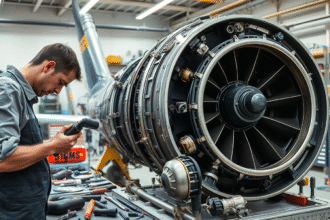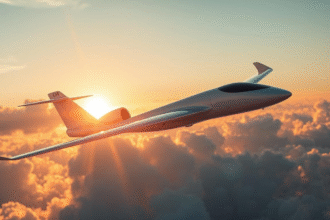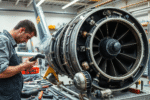Thinking back on my journey into private flying, I remember the excitement and freedom it brought. Private aviation lets people fly on their own schedule, giving them a unique sense of control.
General aviation & Small aircraft
General aviation and small aircraft open doors to new adventures and unforgettable moments. Whether you’re exploring new places or just enjoying the flight, private aviation has something for everyone.
Key Takeaways
- Private aviation offers a unique level of freedom and flexibility.
- General aviation and small aircraft provide access to new adventures.
- The world of private flying is full of exciting experiences.
- Private aviation caters to a wide range of interests and preferences.
- Exploring the world through private aviation can be incredibly rewarding.
The World of General Aviation
General aviation is a big part of the aviation world in the United States. It includes flying for fun, business, and learning to fly. It’s different from flying for work or on scheduled trips.
What Defines General Aviation
General aviation is all about freedom and flexibility for pilots. It’s not like commercial flying, which focuses on carrying people and things on set times. General aviation lets people fly whenever they want, for themselves or their business.
The Scope and Scale in the United States
The general aviation scene in the U.S. is huge. It has thousands of airports and airstrips. It supports many activities, like flying for fun, learning to fly, and even medical transport.
Some interesting facts about it are:
- Over 200,000 general aviation aircraft are registered in the U.S.
- More than 5,000 public-use airports serve general aviation.
- It helps the U.S. economy by creating jobs and spending money locally.
general aviation industry
How General Aviation Differs from Commercial Flying
General aviation and commercial flying are different in many ways. Commercial flying is all about carrying people or goods for money. General aviation is more about flying for personal or specific business reasons.
Key differences include:
- Purpose of Flight: General aviation flights are often for personal or business needs, not for hire.
- Aircraft Types: General aviation uses a wide range of planes, from small single-engine planes to big business jets.
- Regulatory Framework: General aviation has its own rules and guidelines, different from those for commercial airlines.
Understanding Small Aircraft Categories
Small aircraft for general aviation are divided into several categories. They offer pilots many options for flying, whether for fun, training, or work. Each category meets different needs, making flying accessible for everyone.
Single-Engine Piston Aircraft
Single-engine piston aircraft are very common. They’re great for training, touring, and personal flying. Affordability and simplicity make them perfect for new pilots. The Cessna 172 is a well-known example.
Multi-Engine Aircraft
Multi-engine aircraft have more power and are better for long flights and tough conditions. They require special training because of their complexity and unique performance.
small aircraft categories
Light Sport Aircraft (LSA)
Light Sport Aircraft (LSA) are very light and easy to use. They’re limited by rules to keep them simple and safe. This makes them available to more pilots.
Experimental and Homebuilt Options
Experimental and homebuilt aircraft are a special part of general aviation. They’re built by their owners or amateur builders. This offers a unique flying experience and a chance to be part of the building process.
| Aircraft Category | Typical Use | Complexity Level |
| Single-Engine Piston | Training, Touring | Low-Moderate |
| Multi-Engine | Long-distance, Complex Missions | High |
| Light Sport Aircraft (LSA) | Recreational Flying | Low |
| Experimental/Homebuilt | Personal Projects, Enthuasiast Flying | Varies |
Knowing about these categories helps pilots and aviation fans see the variety in general aviation. It helps them make better choices for their flying needs.
General Aviation & Small Aircraft: My Personal Journey
The world of small private planes has been a fascinating journey. It’s filled with learning and personal growth. Reflecting on my experiences, I remember the excitement and curiosity that started my journey in general aviation.
First Encounters with Private Flying
My first time in private aviation was at a local airfield. I took a discovery flight there. The thrill of being in the cockpit was exhilarating. It made me want to learn more about flying small private planes.
The Learning Curve and Challenges
Starting my training, I faced a steep learning curve. I had to learn about weather patterns and master aircraft controls. But with each challenge, my confidence grew. I became more passionate about private aviation.
- Understanding aviation regulations
- Mastering navigation techniques
- Developing situational awareness
Transformative Experiences in the Cockpit
One transformative experience was a solo flight through changing weather. It tested my skills and decision-making. Successfully landing was a moment of pride. It showed me the freedom that private aviation offers.
In conclusion, my journey into general aviation and small aircraft has been rewarding. It’s not just about flying. It’s about the people you meet, the challenges you overcome, and the personal growth you experience.
Popular Small Aircraft Models and Manufacturers
The world of general aviation is full of variety. Many aircraft models meet different needs and tastes. Some manufacturers are known for their quality, performance, and new ideas.
Cessna: The Industry Standard
Cessna is a top name in general aviation. They make reliable and flexible aircraft. The Cessna 172 and Cessna 206 are industry standards, known for their strength and easy handling.
Cessna’s focus on quality has made their planes popular. Both new pilots and experienced ones love them.
Piper Aircraft: Versatility and Performance
Piper Aircraft has been around for a long time. They make a variety of planes, from the single-engine Piper Cherokee to the twin-engine Piper Seneca. Their planes are known for versatility and performance.
They are great for many flying needs. This includes training, touring, and business travel.
Cirrus: Innovation and Safety
Cirrus Aircraft has changed the general aviation world. They focus on new designs and safety. The Cirrus SR22 has a state-of-the-art avionics system and a ballistic parachute.
This makes flying safer and easier for pilots.
Diamond Aircraft: Efficiency and Modern Design
Diamond Aircraft is known for their modern looks and fuel-saving engines. Models like the Diamond DA40 and DA62 have advanced aerodynamics and comfort.
They are perfect for long trips and learning to fly.
There’s a wide range of small aircraft models and manufacturers. This gives pilots many choices. Whether you’re experienced or just starting, knowing about different planes helps you choose the right one.
Getting Your Wings: Training and Certification
If you’re interested in general aviation, getting a private pilot license is the first step. It’s a challenging but rewarding journey. You’ll learn to fly small aircraft safely and explore new travel options.
Private Pilot License Requirements
To begin, you need to meet FAA requirements. You must be at least 17, read, speak, write, and understand English well. Also, you need a valid third-class medical certificate. The training includes at least 40 hours of flying, including solo and night flights.
Finding the Right Flight School
Choosing the right flight school is key. Look at the school’s reputation, instructor experience, aircraft quality, and cost. Many offer introductory flights to help you decide.
The Training Timeline and Expectations
The time it takes to get your private pilot license varies. It depends on how often you fly and how quickly you learn. On average, it can take a few months to a year or more.
Advanced Ratings and Certifications
After your private pilot license, you can get advanced ratings. An instrument rating lets you fly in bad weather. A commercial pilot license is needed for flying for pay. Both improve your skills and open up more aviation opportunities.
| License/Rating | Description | Typical Cost |
| Private Pilot License | Basic license for private flying | $5,000 – $10,000 |
| Instrument Rating | Allows flying in IMC | $8,000 – $12,000 |
| Commercial Pilot License | Required for flying for hire | $10,000 – $20,000 |
The Economics of Small Aircraft Ownership
Buying a small aircraft is more than just the price. It’s about knowing the whole financial picture. Owning a small plane means dealing with costs from the start to the ongoing expenses and taxes.
Purchase Costs Across Different Aircraft Types
The price of a small plane varies a lot. For example, a Cessna 172 can cost between $200,000 and over $500,000. A Cirrus SR22, with its advanced features, can cost between $600,000 to over $1 million.
Key factors influencing purchase costs include:
- Aircraft type and model
- Age and condition of the aircraft
- Avionics and additional features
- Maintenance and upgrade history
Ongoing Expenses: Maintenance, Hangar, and Insurance
After buying, there are many ongoing costs. Maintenance can cost between $1,000 to $5,000 a year. Hangar fees can be $100 to $500 monthly, depending on where you are.
Insurance is also a big deal. It depends on the pilot’s experience, the plane’s value, and how you plan to use it. Annual insurance can be a few hundred dollars or several thousand dollars.
Alternatives to Ownership: Rentals and Flying Clubs
If you don’t want to own a plane, there are other options. Rentals let you fly by the hour without the long-term costs. Flying clubs offer shared ownership, splitting costs and use among members.
Tax Considerations for Aircraft Owners
There are tax benefits to owning a plane, like deductions for business use. It’s smart to talk to a tax expert to understand your tax situation.
In summary, owning a small plane is complex. It involves not just the initial cost but also ongoing expenses and tax implications. Knowing these details helps make better choices in the general aviation world.
Practical Applications of General Aviation
General aviation is more than just flying for fun. It has many uses that affect our daily lives and industries.
Business Travel and Efficiency
General aviation makes business travel better by being flexible and efficient. Companies use private planes to get key people to their destinations fast. This saves time and boosts productivity.
This is great for businesses with many locations or those in areas with little commercial air service.
Aerial Photography and Surveying
Aerial photography and surveying are key uses of general aviation. Planes with special cameras and sensors take detailed photos and gather data. This helps in mapping, environmental checks, and checking infrastructure.
This tech is useful for many industries, like construction, farming, and saving the environment.
Humanitarian and Medical Transport
General aviation is also vital for helping people and moving medical teams. Planes carry aid, medical staff, and patients in emergencies. Groups like Angel Flight and Orphan Transport use it to help others, showing its value beyond regular flying.
Agricultural and Environmental Applications
In farming, general aviation helps with crop watching, fertilizing, and fighting pests. It’s also used in saving the environment, like in wildlife studies and fighting fires. These uses show how versatile and useful general aviation is for different fields.
| Application | Industry | Benefits |
| Business Travel | Corporate | Time-saving, increased productivity |
| Aerial Photography | Construction, Environmental | High-resolution imaging, data collection |
| Medical Transport | Healthcare | Emergency patient transport, medical supply delivery |
| Agricultural Services | Agriculture | Crop monitoring, pest control, fertilization |
Safety Considerations and Best Practices
For pilots of small aircraft, knowing and following safety best practices is key. It ensures a safe flight. Safety in general aviation is complex, needing attention to many factors.
Understanding Aviation Safety Statistics
Aviation safety stats offer insights into flying small aircraft risks. By looking at accident data, pilots can spot common safety issues. This helps them take steps to avoid these problems.
For example, stats often show the importance of knowing the weather, getting the right training, and keeping the aircraft in good shape.
| Cause | Percentage of Accidents |
| Weather-related | 23% |
| Pilot Error | 52% |
| Mechanical Failure | 15% |
| Other | 10% |
Weather Decision-Making
Weather decision-making is a big part of safety in general aviation. Pilots need to understand weather forecasts and make smart flying decisions. This means knowing how to read weather data and understanding their own limits and the aircraft’s abilities.
Continuous Training and Proficiency
For pilots, staying trained and proficient is vital. Regular training keeps them up-to-date with new techniques and rules. This helps them handle emergencies and unexpected situations better.
- Regular flight reviews
- Simulation training for emergency scenarios
- Staying updated with aviation regulations
Modern Safety Technologies in Small Aircraft
Modern safety tech has greatly improved safety in small aircraft. Tools like GPS, terrain awareness warning systems (TAWS), and automatic dependent surveillance-broadcast (ADS-B) are key. They help prevent accidents and improve awareness.
Key safety technologies include:
- GPS and navigation systems
- TAWS and collision avoidance systems
- ADS-B for enhanced situational awareness
In conclusion, safety in general aviation is a big job. It involves understanding safety stats, making smart weather decisions, staying trained, and using modern tech. By following these steps, pilots can make flying much safer.
Conclusion: Your Personal Flight Path
As we wrap up our journey in general aviation and small aircraft, it’s clear that private aviation is special. It offers a unique way to explore the skies. Whether you love the freedom of flying, the speed of business travel, or the excitement of adventure, there’s something for everyone.
Exploring general aviation & small aircraft has opened my eyes to endless possibilities. From single-engine planes to modern light sport aircraft, there’s a wide range to choose from. Private aviation is more than just flying; it’s about the experiences, connections, and opportunities it brings.
Thinking about your own journey in general aviation? Remember, it starts with one flight. Take that first step, and you might find a new passion or a better way to travel. The world of private aviation is full of possibilities and adventures waiting for you.
FAQ
What is general aviation, and how does it differ from commercial aviation?
General aviation includes flying for non-commercial reasons. This includes private flights, training, and medical transport. It’s different from commercial flying because of its varied uses and operations.
What are the different categories of small aircraft used in general aviation?
In general aviation, small aircraft are divided into types. These include single-engine planes, multi-engine planes, Light Sport Aircraft (LSA), and homebuilt planes. Each type has its own features and uses.
How do I become a licensed pilot for general aviation?
To get a pilot’s license, you need to pass several steps. First, complete flight training hours. Then, pass a medical check and exams. Look for a certified flight school and follow their training plan.
What are the costs associated with owning a small aircraft?
Owning a small plane costs money. You’ll pay for the plane itself, maintenance, hangar fees, insurance, and fuel. The total cost depends on the plane, how often you fly, and other factors.
Are there alternatives to owning a small aircraft for general aviation?
Yes, there are other ways to enjoy general aviation. You can rent planes, join flying clubs, or use fractional ownership programs. These options offer flexibility and access without the full cost of owning a plane.
What safety considerations are critical for general aviation pilots?
Safety is key in general aviation. Pilots need to know about safety stats, make smart weather decisions, stay trained, and use the latest safety tech in small planes.
Can general aviation be used for purposes other than recreational flying?
Definitely, general aviation has many practical uses. It’s great for business travel, aerial photos, medical transport, and more. It shows how versatile and useful it can be.
What are some of the popular small aircraft models and manufacturers?
Popular models come from Cessna, Piper, Cirrus, and Diamond Aircraft. Cessna is known for reliability, Piper for versatility, Cirrus for innovation, and Diamond for modern design and efficiency.







